Investors Place Bets on Global Economic Recovery, Propelling Stocks Higher
Stock-Markets / Financial Markets 2009 Jul 26, 2009 - 02:53 PM GMT Goodbye safe havens, hello risky assets” seemed to be the theme during the past week as investors placed their bets on a global economic recovery, propelling stocks and other risky assets higher amid better-than-expected earnings reports and tentative signs of stabilization in the US job and housing markets.
Goodbye safe havens, hello risky assets” seemed to be the theme during the past week as investors placed their bets on a global economic recovery, propelling stocks and other risky assets higher amid better-than-expected earnings reports and tentative signs of stabilization in the US job and housing markets.

Source: Jerry Holbert, Comics.com, July 23, 2009.
Not only did the Dow Jones Industrial Index on Thursday breach 9,000 for the first time since January and the Nasdaq Composite Index notch up a streak of 12 consecutive advancing days, but other global stock markets, commodities, oil, precious metals, high-yielding currencies and corporate bonds also put in a stellar performance as a bullish mood prevailed.
Bonds and other safe-haven assets such as the US dollar and Japanese yen were out of favor as investors sought higher returns elsewhere. Also, the CBOE Volatility Index (VIX), or “fear gauge” was at its lowest level (23.1) since before the Lehman collapse in September.
The past week’s performance of the major asset classes is summarized by the chart below - a set of numbers that indicates an increase in risk appetite.
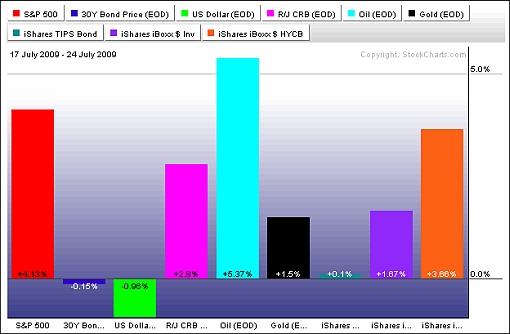
Source: StockCharts.com
A summary of the movements of major stock markets for the past week, as well as various other measurement periods, is given below. As the second-quarter corporate results in the US rolled in, the American and most other markets closed the week in solid positive territory.
The MSCI World Index (+4.6%) and MSCI Emerging Markets Index (+5.2%) last week again added to the rally’s gains to take the year-to-date returns to +11.7% and a massive +45.3% respectively. Strikingly, the World Index advanced for ten straight sessions through Friday, whereas the Emerging Markets Index gained on nine of the past ten trading days.
The major US indices are all back in the black for the year to date, with each index having fallen for only one day last week. Prior to a slight decline on Friday, the Nasdaq Composite Index experienced its best winning streak since 1992 as it rose for 12 sessions in a row.

Stock market returns for the week ranged from top performers Romania (+11.1%), Russia (+9.5%), Egypt (+8.8%), Hong Kong (+7.9%) and Poland (+7.8%) to Greece (-3.6%), Bermuda (-2.5%), Jamaica (-2.0%), Côte d’Ivoire (-1.9%) and Bangladesh (-1.0%) at the other end of the scale.
Of the 97 stock markets I keep on my radar screen, a majority of 82% recorded gains, 15% showed losses and 3% unchanged. (Click here to access a complete list of global stock market movements, as supplied by Emerginvest.)
As an aside, the capitalization of China’s stock market is currently $3.2 trillion compared with $11.2 trillion for the US market, according to data compiled by Bloomberg. Mark Mobius, head of emerging markets at Templeton Asset Management, said (via MoneyNews) China might surpass the US as the world’s largest stock market in as little as three years, as China’s state-owned companies will sell new shares and the nation’s 1.4 billion people will put more of their money into the market.
Back to the corporate reporting season in the US. Of the 142 S&P 500 companies that have so far announced quarterly results, 111 came out ahead of earnings expectations, 10 in line and 21 below. While the earnings announcements thus far have been impressive at the headline level, the reports become less striking once one digs a bit deeper to discover that the earnings numbers often only beat estimates due to cost-cutting.
At the top line revenues are still deflating, indicating no pricing power. Specifically, 72 companies posted revenue that failed to live up to expectations. But the prospects are looking up as for the first time in quite a while many more companies are raising guidance versus lowering guidance.
John Nyaradi (Wall Street Sector Selector) reports that as far as exchange-traded funds (ETFs) are concerned, the winners for the week included Claymore/MAC Global Solar Energy (TAN) (+17.9%), PowerShares Biotech & Genome (PBE) (+17.4%) and Market Vectors Solar Energy (KWT) (+15.9%). Among the country ETFs, Market Vectors Russia (RSX) (+ 12.5%) performed splendidly.
On the losing side of the slate, ETFs included “all things short” such as ProShares Short MSCI Emerging Markets (EUM) (-6.2%), ProShares Short QQQ (PSQ) (-5.0%) and ProShares Short Russell 2000 (RWM) (-4.9%).
As far as credit is concerned, the cost of buying credit insurance for US and European companies eased sharply during last week’s trading, as shown by the narrower spreads for both the CDX (North American, investment-grade) Index (down from 131 to 118) and the Markit iTraxx Europe Index (down from 107 to 95).
CDX (North America, investment-grade) Index
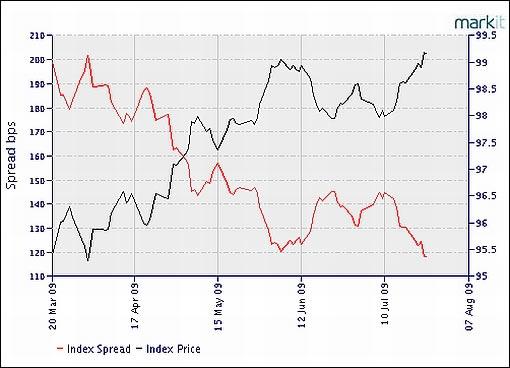
Source: Markit
The quote du jour this week comes from Bill King (The King Report) who said: “Sorry, Mr. President - you ‘wasted a good crisis’. You, Ben, Hank, W, Little Timmy and Democratic Congressional leaders told Americans that the world would end unless US taxpayers mortgaged whatever little future remained in order to provide record stimulus now. You and your ilk said there was no time to delay. Remember you said ‘catastrophe’ would occur if there was no stimulus. You and your team boasted that millions of jobs would be created. No jobs yet. But Goldman Sachs and other insiders minted more money and numerous crony capitalists were able to salvage as much net worth as possible.
“Americans have yet to express the appropriate and proportional opprobrium at the ruling class. But as night follows day, they will; and the longer the delay, the more intense the reaction will be.
“As we keep asserting, the underlying structural problems in the US economy and financial system have not even remotely been addressed. There will be no significant recovery until the necessary restructuring occurs. And there can be no necessary restructuring until the requisite hellacious purge occurs.”
Other news is that President Obama’s healthcare reform got delayed as mounting concerns were voiced about costs. Elsewhere, CIT - a company which provides finance to almost one million small and medium-sized companies in the US - on Monday received a $3 billion private rescue package, enabling the troubled finance group to avoid bankruptcy. Also, the Federal Deposit Insurance Corp (FDIC) closed six more banks on Friday, bringing the tally of US bank failures in 2009 to 64.
Next, a quick textual analysis of my week’s reading. No surprises here, with all the usual suspects such as “banks”, “economy”, “market” and “funds” featuring prominently.
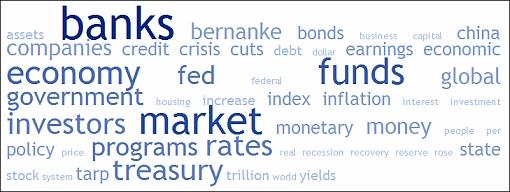
The key moving-average levels for the major US indices, the BRIC countries and South Africa (my home country) are given in the table below. All the indices trade above their respective 50- and 200-day moving averages.
Importantly, the 50-day lines are in all instances also above the 200-day lines and therefore not threatening the bullish “golden crosses” established when the 50-day averages broke upwards through the 200-day averages.
The June highs and July lows are also given in the table as these levels define a support area for a number of the indices.
Click here or on the table below for a larger image.

For more on key levels and the most likely short-term direction of the S&P 500 Index, Adam Hewison’s (INO.com) short technical analysis provides valuable insight. Click here to access the presentation. (Adam also covered the outlook for crude oil, gold and the dollar/yen exchange rate in recent analyses. Click the links to view these.)
Interestingly, sentiment is still showing plenty of skepticism. “If twelve straight days of gains in the Nasdaq won’t bring out the bulls, what will?” asked Bespoke. According to the most recent survey by the American Association of Individual Investors (AAII), bears (42.4%) among individual investors still outnumber bulls (37.6%). As far as newsletters are concerned, bullish writers outnumber bearish writers by a slim margin (36.7% versus 35.6%), as surveyed by Investors Intelligence.
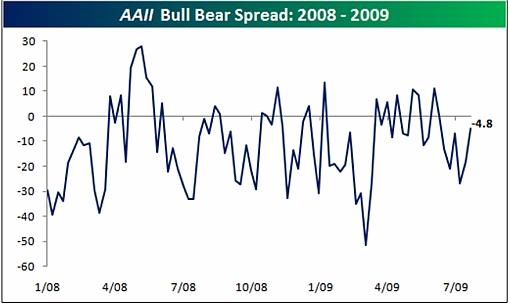
Source: Bespoke, July 23, 2009.
The 10-day average of daily advancers minus decliners is a useful indicator of stock market breadth and helps to identify inflection points. The chart below, courtesy of Bespoke, shows the 10-day advance/decline line for the S&P 500 Index. “… the recent rally has put the A/D line well into overbought territory and at a level that has indeed marked a peak during prior rallies in the past year. After 12 up days for the Nasdaq and an average gain of 13% for S&P 500 stocks since July 10, it’s time for a breather,” said Bespoke.
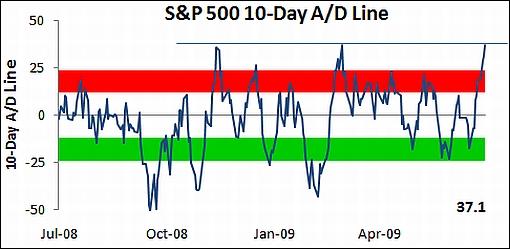
Source: Bespoke, July 23, 2009.
The long-awaited Dow Theory bull signal finally arrived on Thursday. This came about as a result of the Dow Jones Industrial Average and the Dow Jones Transportation Average both breaking through their previous rally peaks (registered on 12 and 11 June respectively).
Richard Russell, “Mr Dow Theory” and author of the Dow Theory Letters, forthwith replaced the bear on the first page of his daily newsletter with a long-horned Texas bull. The long-timer said: “I believe we are now dealing with an extended bear market rally (some will call it a cyclical bull market). But I’m operating on the thesis that a primary (secular) bear market is still in force (although it has been suspended for a while). In my opinion, the true final bottom for this secular bear market lies somewhere ahead.
“Remember, on March 9 very few of the items characteristic of a true bear market bottom were seen. There was no extreme pessimism, there were no huge bargains in stocks, and the public continued to be hopeful. On this evidence, I concluded that the final and true bottom of the bear market had not been seen.”
While Dow Theorists delight in the bull signal, it is appropriate not to lose sight of the economic picture, as aptly summarized by David Rosenberg, chief economist and strategist of Gluskin Sheff & Associates: “Well, the S&P 500 surged 15% in the second quarter and what we did was go back in the history books to see what happens to the economy the very next quarter typically after such a big bounce and the answer is … just over 3% real GDP growth. So consider that de facto what is being discounted at this time for current quarter growth - it better be a humdinger of an inventory build.
“Now, for the market to build on such a rapid advance in the current quarter, history again suggests that we would need to see 5.5% real GDP growth, which we give near-zero odds of occurring. Hence our call for a sputtering stock market through year end. Too much growth - and hope - are priced in at this point.”
Although I maintain that stock markets are in a broad bottoming-out phase, I am concerned that prices have moved too far ahead of economic reality. I am therefore adopting a cautious approach in anticipation of the market working off the overbought condition and fundamentals reasserting themselves.
For more discussion on the direction of financial markets, see my recent posts “Video-o-rama: Dow back above 9,000“, “Earnings - not what they seem?“, “Dow Theory calls a bull market“, “Coppock shows bottom in Treasuries“, “Is the yield curve indicating better tidings?“, and “US dollar about to pop?“. (And do make a point of listening to Donald Coxe’s webcast of July 24, which can be accessed from the sidebar of the Investment Postcards site.)
Economy
“Global business confidence continues to make steady gains. There was a substantive improvement last week in businesses’ broad assessments of current conditions to its strongest level since just after the start of the current financial crisis nearly two years ago. Sentiment in the US also improved notably last week,” said the latest Survey of Business Confidence of the World conducted by Moody’s Economy.com. “Despite the steady improvement in confidence it remains consistent with ongoing global recession.”
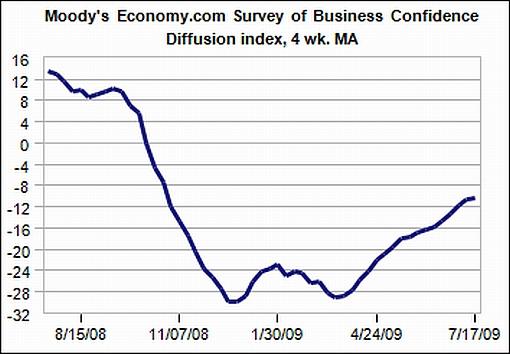
Source: Moody’s Economy.com
Ifo reported that its Business Climate Index for industry and trade in Germany rose again in July. “The firms are no longer quite as dissatisfied with their current business situation as in the previous month. They are again less skeptical regarding business developments in the coming half year. It seems that the economy is gaining traction.”
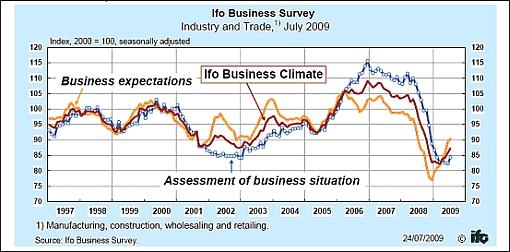
Source: Ifo, July 24, 2009.
However, Rebecca Wilder (News N Economics) warns: “… a compilation of indicators shows that the recovery is tentative at best - more likely, a global bottom has not yet been found. The leading indicators are stronger in some countries; exports are still declining at an annual pace of 20%+ but stabilizing; and volatile retail sales growth rates are, well, quirky.”
Stephen Roach, chairman of Morgan Stanley Asia, is also downbeat about the global economic outlook, saying (via MoneyNews): “Sorry to break the news, but the financial crisis is not over. You’ve got plenty more write-offs of bad paper to come. Developed economies haven’t broken out of recession yet. Seventy-five percent of the world’s economies today are still contracting, and the biggest piece on the demand side of the global economy is the American consumer, who is dead in the water.”
A snapshot of the week’s small number of US economic reports is provided below. (Click on the dates to see Northern Trust’s assessment of the various data releases.)
July 24
• Tracking a few of the Fed’s extraordinary programs
July 23
• June Existing Home Sales report - sales, inventories and prices moving in the desired direction
• Initial jobless claims increase; decline in continuing claims is misleading
July 22
• Housing market update - mortgage applications and FHFA House Price Index
July 21
• Fed’s exit strategy - a deft and fortunate Fed?
July 20
• Leading Economic Indicators - history suggests economic recovery is around the corner
The Conference Board’s Index of Leading Economic Indicators came in above expectations in June, gaining 0.7% against May and rising for the third consecutive month. However, David Rosenberg (Gluskin Sheff & Associates), cautioned not to get all excited about this green shoot. “… the ‘here and now’ indicator (the coincident index) is still showing declines (now down eight months in a row) and the level, at 100.3, is the lowest since September 2004. As the chart below shows, recessions do not end until this metric carves out a bottom (irrespective of the coincident/lagging ratio).”
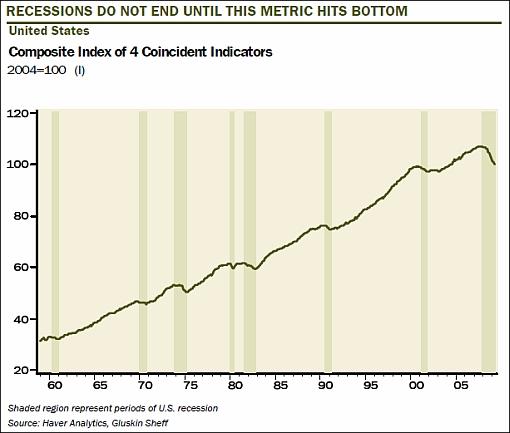
Source: David Rosenberg, Gluskin Sheff - Breakfast with Dave, July 23, 2009.
In his semiannual Monetary Policy Report to Congress on Tuesday, Fed chairman Ben Bernanke said: “The FOMC anticipates that economic conditions are likely to warrant maintaining the Federal funds rate at exceptionally low levels for an extended period. I want to be clear that we have a very long haul here because, even if the economy begins to turn up in terms of production, unemployment is going to stay high for quite a while, so it’s not going to feel like a really strong economy.”
Is Bernanke’s scenario the one the stock market is discounting?
Week’s economic reports
The US economic highlights for the coming week include the following:
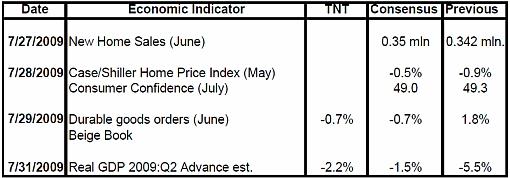
Source: Northern Trust
Click here for a summary of Wells Fargo Securities’ weekly economic and financial commentary.
Markets
The performance chart obtained from the Wall Street Journal Online shows how different global financial markets performed during the past week.
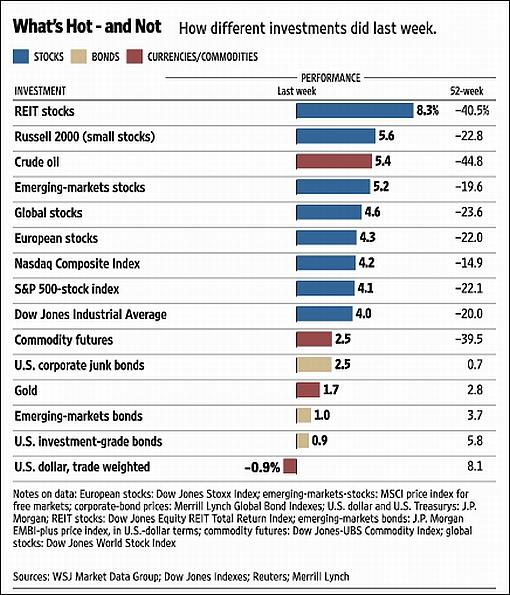
Source: Wall Street Journal Online, July 24, 2009.
“As a general rule, the most successful man in life is the man who has the best information,” said Benjamin Disraeli, British Prime Minister and novelist in the 19th century. Let’s hope that the news items and quotes from market commentators included in the “Words from the Wise” review will assist Investment Postcards readers to assimilate appropriate information for taking correct investment decisions.
For short comments - maximum 140 characters - on topical economic and market issues, web links and graphs, you can also follow me on Twitter by clicking here.
That’s the way it looks from Cape Town (where the sun is making the winter days very pleasant).
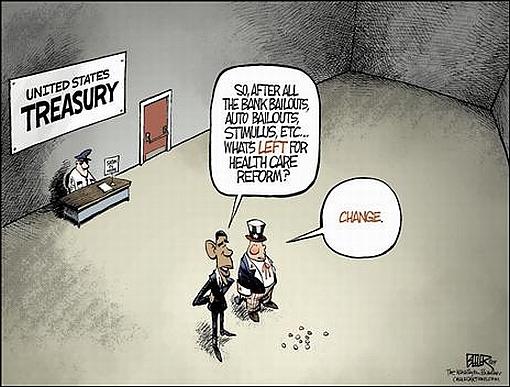
Source: Nate Beeler, July 22, 2009.
CNBC: Warren starring on the web
“The most famous investor of all time is now cartoon character, with Warren Buffett, Berkshire Hathaway chairman/CEO.”
Source: CNBC, April 24, 2009.
Chart of the Day (Clusterstock): The amazing expanding bailout
“Tarp watchdog Neil Barofsky says the total size of the bailout has now hit $23.7 trillion, when all the guarantees are factored in. Of course, the government doesn’t just provide a bailout total, so different parties may come up with different numbers. But one thing’s clear: ever since the first bailout, the estimate has grown and grown and grown and grown and grown. Let’s hope today’s number is as big as it gets.”
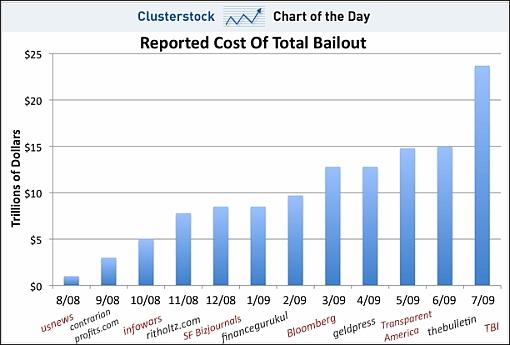
Click here for Bloomberg’s take on this story.
Source: Joe Weisenthal and Kamelia Angelova, Clusterstock - The Business Insider, July 20, 2009.
MoneyNews: Banks still on the hook for $470 billion
“Banks have failed to make adequate provision for the losses on loans and securities they face before the end of next year, a new report from Moody’s Investors Service says.
“As a result, US banks may incur about $470 billion of losses and writedowns by the end of 2010, potentially causing them to be unprofitable next year.
“Plus, higher credit and funding costs may force a re-pricing of credit, Moody’s said.
“‘Large loan losses have yet to be recognized in the banking system,’ the report noted.
“‘We expect to see rising provisioning needs well into 2010.’
“‘The fundamentals of financial institutions are still traveling on a downward slope,’ Moody’s said. ‘No-one should consider recent improvements as assurance that the current rebound can be sustained.’
“The report also noted that banks would be additionally challenged by having to deal with tighter regulation.
“The problem isn’t confined to the United States.
“Christian Clausen, CEO of Nordea Bank, says Nordic lenders have yet to reach the pinnacle of their bad-debt problems.
“‘The risk for somewhat higher loan losses has increased,’ Clausen told Dow Jones Newswires, referring to both Nordea and to the Nordic banking sector in general.
“Meanwhile, German newspapers report that the German government may force banks to take state aid to ward off a credit crunch later this year.”
Source: Julie Crawshaw, MoneyNews, July 21, 2009.
Financial Times: California spending cuts spark fury
“California erupted in protest on Tuesday as teachers, local governments and public sector workers attacked the billions of dollars of spending cuts that form the basis of the state’s controversial budget deal.
“The agreement to close California’s record $26.3 billion deficit was reached after Arnold Schwarzenegger, the state’s governor, agreed swingeing cuts, including $6 billion off education spending.
“It comes as the state has been forced to write IOUs to creditors after running out of money. Public employees have had to take unpaid leave and the state’s credit rating has been slashed to near junk status, giving it the worst rating in the US.
“The budget deal should alleviate some pressure. But opponents of Mr Schwarzenegger’s plan are likely to resist the billions of spending cuts he has identified.
“‘We used to have the best schools in the country but education in California is taking 60% of the cuts,’ said David Sanchez, president of the California Teachers’ Association.
“As much as $4.7 billion will be taken from cities and municipalities, heaping more pressure on local efforts to fight the slump.
“Antonio Villaraigosa, mayor of Los Angeles, said it was a ‘moment of shame’ for California, adding the state had ‘abdicated and abrogated its commitment to cities, school districts and counties’.
“Unemployment in California is running at more than 11.5%, while businesses are leaving the state, lured by more appealing tax regimes in states such as Colorado and Texas.”
Source: Matthew Garrahan, Financial Times, July 21, 2009.
Financial Times: Fiscal problems of US states to continue
“The fiscal problems of US states will continue even though lawmakers have received federal stimulus funds and made sweeping cuts to close shortfalls in their budgets for recent years, according to a report by a leading bipartisan research group.
“States had to close a $142.6 billion gap as legislatures enacted their budgets for the latest fiscal year, which began on July 1 for 46 of 50 states, said a report from the National Conference of State Legislatures released on Monday.
“That followed a cumulative shortfall of $113.2 billion for the previous year.
“The cumulative state budget shortfall during the last recession, which spanned fiscal years 2002 to 2006, was $263.8 billion, according to the report. The totals for fiscal 2008 through 2010, plus the projected numbers for years 2011 and 2012, already show a gap of at least $348.2 billion.”
Source: Nicole Bullock, Financial Times, July 20, 2009.
Financial Times: CIT board approves $3 billion rescue package
“CIT’s board on Monday approved a two-year, $3 billion rescue package with a group of lenders enabling the troubled US finance group to avoid a bankruptcy filing, after round-the-clock weekend talks.
“One party to the financing said: ‘This paves the way for an orderly restructuring of the balance sheet with time and capital. And it will give CIT’s customers plenty of capital.’
“The company, which provides finance to nearly 1 million small and medium-sized companies in the US, and its creditors had to move quickly to arrest a slide into bankruptcy and prevent its best customers from defecting for fear the lender could no longer support them.
“The rescue finance will not come cheaply. The yield on the paper is expected to be about 11%, generous enough to give potential lenders an incentive to provide capital out of court.
“Many creditors, led by banks such as JPMorgan Chase, had hoped to provide financing in the context of a bankruptcy filing, which would give them a first call on all CIT’s assets. But such debtor-in-possession financing might not have offered such a lucrative yield.
“The rescue financing will come as a relief to the government: had CIT filed for bankruptcy protection, the Treasury would probably have lost the $2.3 billion of bail-out funds CIT received last year. It would also have been a huge embarrassment for the Fed, which had described CIT as adequately capitalised when it approved its banking application.”
Source: Henny Sender and Francesco Guerrera, Financial Times, July 20, 2009.
Financial Times: FSA takes tougher line on regulation
“Regulators from the Financial Services Authority are sitting in on bank board meetings, demanding more data and questioning brokers’ business plans as part of the harder line they have adopted in the wake of the credit crunch.
“The City regulator has also expanded its list of strategically important institutions, which it subjects to close supervision, from 50 to 75.
“Individual directors say they are being interviewed more frequently, and the FSA is asking not only about their qualifications but also about how they do their jobs and the judgments they have made. Business proposals are being scoured in a fashion that would have been unthinkable two years ago.
“FSA officials say the tighter oversight is a result of efforts to improve supervision in the wake of the failure of Northern Rock and other banking sector woes. It is part of a larger plan that also includes a proposal to increase fines and hiring 280 more supervisory personnel.
“‘There’s a lot more detailed investigation and requests for numbers, a lot more fundamental analysis of the building blocks. We are a lot less reliant on what the firms are telling us,’ said Lyndon Nelson, FSA head of risk.
“While some in the industry welcome the FSA’s efforts to do more to control risk, others are uncomfortable with having observers at their board meetings and some question whether the regulatory staff are up to the task.
“‘They don’t work. They don’t read. We send them stuff and we can tell that they haven’t read it,’ says the chief executive of one midsized City institution.
“Mr Nelson said: ‘There have been times when bankers may have questioned us but we have worked hard to improve the quality of our people through both training and recruitment.’”
Source: Brooke Masters, Financial Times, July 19, 2009.
CNBC: Marc Faber says ultimate crisis still coming
“The world has not seen the end of the financial crisis and the recent surge in markets was a result of excess liquidity coming from central banks, Marc Faber told CNBC in an interview.
“‘If you pump money into the system and you create large fiscal deficits, you create volatility,’ Faber, author of the Gloom, Boom and Doom Report, told CNBC in remarks reported on its website. ‘We’ve seen an intermediate low in March, we’ll rally for a year or so or maybe 18 months - the ultimate crisis will happen much later, and the ultimate crisis would clean the system,’ he added.
“Faber, who did not forecast a precise time for that crisis, told CNBC that firing half the government workers in the world would be one way of dealing with the crisis. ‘If you shift government activity to the private sector the economy becomes more dynamic,’ Faber said.”
Source: CNBC, July 17, 2009.
MoneyNews: Roach - financial crisis isn’t over
“While many experts have turned optimistic about the global financial system in recent months, Stephen Roach, chairman of Morgan Stanley Asia, isn’t one of them.
“‘Sorry to break the news, but the financial crisis is not over. You’ve got plenty more write-offs of bad paper to come,’ Roach told CNBC.
“Developed economies haven’t broken out of recession yet, he said.
“‘Seventy-five percent of the world’s economies today are still contracting, and the biggest piece on the demand side of the global economy is the American consumer, who is dead in the water,’ Roach said.
“Stock markets, along with many bonds, have rallied sharply in recent weeks. But Roach said markets have overdone it, given the ‘anemic character of the recovery’.
“The rally largely reflects the excess of liquidity poured into the financial system by central banks, he said.
“‘Liquidity is seeking return, and right now these markets are priced for a recovery that’s going to end up disappointing,’ he said.
“Some experts are excited by recent news of better-than-expected corporate earnings. But those anticipating high profits ‘are going to be in for a rude awakening,’ Roach said.
“Economist Gary Shilling agreed with Roach. ‘I expect the recession to run into the early part of next year,’ he told Bloomberg.
“Excess home inventories and retrenchment in consumer spending will restrain the economy, he said.”
Source: Dan Weil, MoneyNews, July 17, 2009.
Bloomberg: Bernanke gets top marks from global investors in poll
“Global investors give Federal Reserve Chairman Ben Bernanke top marks for combating the worst financial crisis since the Great Depression and overwhelmingly favor his reappointment amid optimism that the world economy is on the mend.
“Sixty-one percent of investors surveyed in the first Quarterly Bloomberg Global Poll say the world economy is stable or improving and almost 75% take a favorable view of the 55-year-old chairman. By almost a three-to-one margin, they say Bernanke has earned another four-year term when his current one expires in January.
“‘He’s the best, maybe around the world,’ said Wallace Lin, an investment manager with Euro Asset Management in Hong Kong, who participated in the poll. Investors ranked Bernanke higher than his counterparts at other major central banks, including European Central Bank President Jean-Claude Trichet.
“The vote of confidence strengthens Bernanke’s hand as he faces congressional criticism that the Fed overstepped its authority by helping to rescue failing financial institutions in the midst of the crisis. It also gives his bid for another term a boost. President Barack Obama has praised Bernanke’s performance atop the central bank without saying whether he wants him to stay.
“‘If he weren’t renominated, it could have potentially very serious and severe repercussions on the stock market and the economy,’ said Jack Liebau, a poll participant and president of Pasadena, California-based Liebau Asset Management Co.
“Investors consider recession a bigger threat to the US economy than rising prices over the next two years, the poll showed. Sixty-one percent cite recession as the greater risk, compared with 37% who name inflation.
“Martin Feldstein, a professor of economics at Harvard University who was considered for the position of Fed chairman before Bernanke took over in 2006, praised the policy maker. Bernanke has ‘done a very good job and I think he should be reappointed’, Feldstein said in an interview yesterday on Bloomberg Television.
“The first Quarterly Bloomberg Global Poll is a survey of investors and analysts on six continents. It is based on interviews from July 14 to July 17 with a random sample of 1,076 Bloomberg subscribers, who represent leading decision makers in markets, finance and economics.”
Source: Rich Miller, Bloomberg, July 22, 2009.
Financial Times: Bernanke outlines Fed’s exit strategy
“Yields on US Treasuries fell sharply on Tuesday as Ben Bernanke outlined the Federal Reserve’s plan to extricate itself from its policy of near-zero interest rates but stressed the economy was too fragile to implement it soon.
“Following increasing pressure from investors and politicians, the Fed chairman set out the central bank’s ‘exit strategy’ for its policies, which have pumped huge amounts of liquidity into the economy and prompted fears about inflation.
“Mr Bernanke stressed however that in spite of glimmers of improvement in the economy, the Fed intended to keep interest rates extremely low for an ‘extended period’.
“‘I want to be clear that we have a very long haul here because, even if the economy begins to turn up in terms of production, unemployment is going to stay high for quite a while, so it’s not going to feel like a really strong economy,’ he said in his biannual report to Congress.
“The Fed expects the economy to start growing again at the end of this year but thinks the unemployment rate - now at 9.5% - will remain elevated through 2011.
“Outlining the Fed’s exit plans, Mr Bernanke said the bank could raise the interest paid on reserve balances to help set a floor under interest rates, and use ‘reverse-repo’ agreements in which it would sell securities from its portfolio with an agreement to buy them back later.
“Mr Bernanke also mounted a defence of the independence of the Fed amid calls for greater scrutiny.”
Source: Sarah O’Connor, Tom Braithwaite, Michael Mackenzie and Dave Shellock, Financial Times, July 21, 2009.
MoneyNews: John Tamny - Bernanke will kill recovery
“Most experts, including investment legend Warren Buffett and former General Electric CEO Jack Welch, say Federal Reserve Chairman Ben Bernanke has done an excellent job handling the financial crisis and should be reappointed.
“But economist John Tamny isn’t among them. He thinks Bernanke’s views are insufficiently monetarist to merit his reappointment.
“‘Rather than defining inflation as something monetary in nature, the Bernanke Fed has reverted to Phillips Curve logic, suggesting inflation results from too much economic growth and too many people working,’ Tamny writes in Forbes.
“‘It would be hard to contemplate a more impoverishing notion than the one that says economic growth is the cause of inflation, and economic weakness is its cure,’ he argues.
“‘What this means is that should the US economy reverse direction in such a way that unemployment falls, the Bernanke Fed would use rate machinations to pour cold water on it as a way of keeping unemployment higher than it otherwise might be,’ Tamny explains.
“‘For this reason alone, Obama should not re-nominate Bernanke.’
“Tamny also blames Bernanke for the 9.5% unemployment rate, though most others attribute the rise in joblessness to the recession that resulted from the financial crisis.
“As for Bernanke supporters, Buffett told CNNMoney.com, ‘I don’t see how you could have anybody better than Ben Bernanke.’”
Source: Dan Weil, MoneyNews, July 20, 2009.
Bloomberg: Fed has become “embroiled” in politics, Poole says
“The Federal Reserve is ‘embroiled’ in politics and has ’stretched beyond reason’ its authority to make loans, said William Poole, who served as president of the St. Louis Fed from 1998 to 2008.
“‘I don’t think independent can mean the Fed can do whatever it wants under any circumstance,’ Poole, a senior economic adviser to Palo Alto, California-based Merk Investments, said in an interview today on Bloomberg Radio. ‘The Fed has chosen to make loans to certain firms and not others.’
“Traditionally, central banks ‘deal in government securities’, and control ‘overall liquidity’ and ‘overall interest rates’, Poole said. The Fed is ‘embroiled in fundamentally political questions’, he said.
“In the aftermath of last year’s credit market collapse, the Fed instituted a series of emergency lending programs. Fed policy makers decided at their meeting June 24 to maintain plans to buy as much as $1.75 trillion of Treasuries and housing debt to lower interest rates.
“The central bank ‘has not made loans of this sort since the Great Depression’, Poole said. ‘The Federal Reserve has responded very aggressively to this crisis we are living through’ and ‘has doubled its balance sheet’.
“The Fed’s role in financial market oversight has since come under scrutiny, with the administration of President Barack Obama proposing, among other things, that the Fed’s ability to make emergency loans be subject to approval by the US Treasury.
“‘It’s important that the Fed be independent on monetary policy, but I worry about what independence might mean in other contexts,’ Poole said. ‘The Fed, it seems to me, has stretched beyond reason its authority to make loans to the private sector, such as the MBS (mortgage-backed securities) purchase program, the lending on commercial paper from large corporations, the bailouts.’”
Source: Vincent Del Giudice and Max Raskin, Bloomberg, July 22, 2009.
Financial Times: Senate delay hits health reform push
“President Barack Obama’s bid to push healthcare reform, his signature policy, through Congress suffered a significant blow on Thursday when the leading Democrat in the US Senate said it would miss a White House deadline to pass the legislation by August.
“The comments by Harry Reid, Senate majority leader, come despite heightened efforts by Mr Obama to win public support for his top legislative priority, including a prime-time press conference on Wednesday night and a ‘town hall’ meeting in Ohio on Thursday.
“The debate is increasingly encompassing topics such as tax increases, restrictions in health services and legislative delay rather than the president’s preferred theme of the long-term need for fundamental reform. Recent polls have also indicated a deep division among the US public about the merits of reform.
“‘It’s better to have a product based on quality and thoughtfulness rather than try to jam something through,’ Mr Reid said on Thursday, adding that senators took the decision to delay on Wednesday night in response to Republican calls for more time.
“While Senate passage before the August recess had looked increasingly unlikely in recent days, the move frustrates Mr Obama’s drive for a vote in both houses in Congress ahead of the summer break.
“Such a course would have cleared the way for negotiations on the reform once Congress returned in September, since the House of Representatives and the Senate would still have to settle their differences over the legislation.
“But now, before that can happen, the administration will have to focus on rounding up votes, even after the break. Momentum has ebbed away from a measure Mr Obama hopes will be his legacy, amid concerns voiced by moderates from both parties about costs.”
Source: Daniel Dombey, Financial Times, July 23, 2009.
The Wall Street Journal: Man who wounded health care overhaul effort could also save it
“Douglas Elmendorf, director of the Congressional Budget Office, told Congress that the president’s sweeping health care plan did not slow spending. Economics Editor David Wessel says that this could be seen as the president’s ‘emperor with no clothes’ moment.”
Source: The Wall Street Journal, July 23, 2009.
Asha Bangalore (Northern Trust): Leading Economic Indicators - history suggests economic recovery is around the corner
“The Index of Leading Economic Indicators (LEI) increased 0.7% in June vs a revised 1.3% gain in May and a 1.2% jump in April. The June increase puts the year-to-year decline at 1.18%. The trough for the year-to-year change appears to have occurred in December 2008 (-3.98%). The year-to-year change of the LEI tracks the trough of the business cycle with a small lead. The mean and median leads of the year-to-year change in the LEI with reference to the troughs of the business cycle are 6.1 months and 7.0 months, respectively.
“Based on history, it appears that a recovery in the latter half of 2009 is gaining support. The longest lead was in the 1981-82 recession and the smallest was during the mini-1980 recession.”
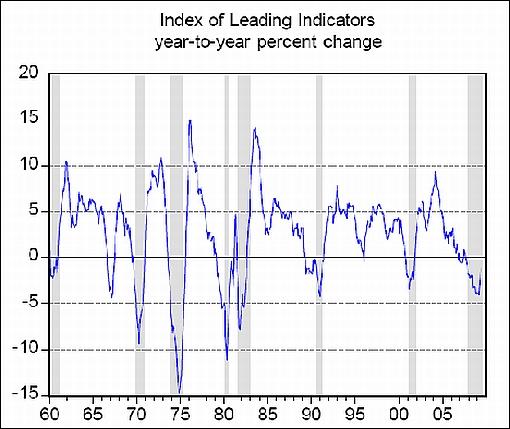
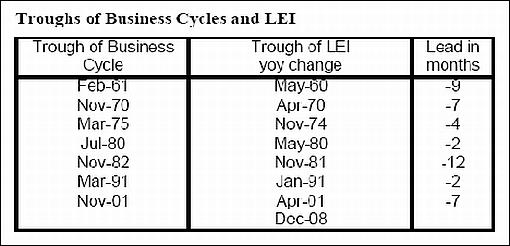
Source: Asha Bangalore, Northern Trust - Daily Global Commentary, July 20, 2009.
Asha Bangalore (Northern Trust): Initial jobless claims increase
“Initial jobless claims increased 30,000 to 554,000 during the week ended July 18, after three consecutive weekly gains. Distortions from seasonal factors based on prior history of auto industry layoffs have played a major role in the seasonally adjusted tally of the past few weeks. It is important to note that auto industry layoffs occurred sooner than expected and that the underlying trend of initial jobless claims is pointing south.

“However, continuing claims, which lag initial claims by one week, fell 88,000 to 6.225 million after a drop of 591,000 in the prior week. But these readings are misleading because unemployed individuals qualify for the Emergency Unemployment Compensation (EUC) Program and Extended Benefit Program after availing of 26 weeks of unemployment compensation in the regular state program, and continuing claims data do not reflect these recipients.
“The main conclusion is that the rate of firing, as reflected in the initial jobless claims data, has slowed but the line for unemployment insurance continues to advance. The downward trend of initial jobless claims, a leading indicator, is the important aspect of the report.”
Source: Asha Bangalore, Northern Trust - Daily Global Commentary, July 23, 2009.
Bill King (The King Report): Core retail sales at new low
“Though the government reports ‘core’ PPI and CPI to mitigate inflation and the Street and financial media eagerly swallow the ploy, the beancounters won’t report ‘core’ retail sales because inflation, principally in gasoline and food prices, boosts retail sales and gives the illusion of growth.
“The Atlanta Fed is now reporting Core Retail Sales. The chart below shows why the Street and government don’t want to report it - it made a new low in June.”
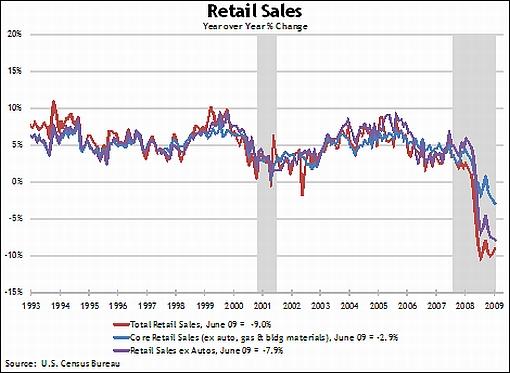
Source: Bill King, The King Report and Atlanta Fed, July 17, 2009.
Asha Bangalore (Northern Trust): Existing home sales report - moving in the desired direction
“Sales of all existing homes rose 3.6% to an annual rate of 4.89 million in June, the third consecutive monthly gain. Sales of single-family existing homes increased 2.4% to an annual rate of 4.32 million in June, also the third monthly increase. The small and sustained increase in sales of existing homes is noteworthy.

“The median price of an existing single-family home at $181,800 during June is down 14.98% from a year ago. The largest year-to-year drop was recorded in April (-16.8%). The moderation in the pace of price declines is significant.
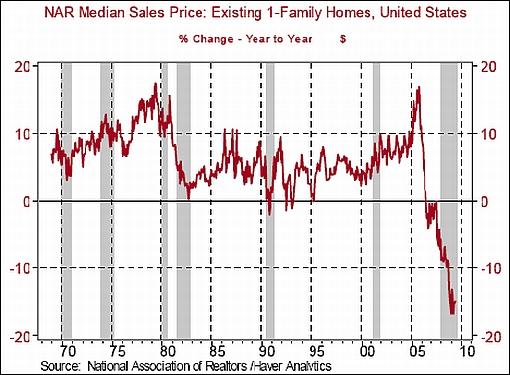
“The seasonally unadjusted inventory of all existing homes declined to a 9.4-month supply from a 9.8-month supply.”
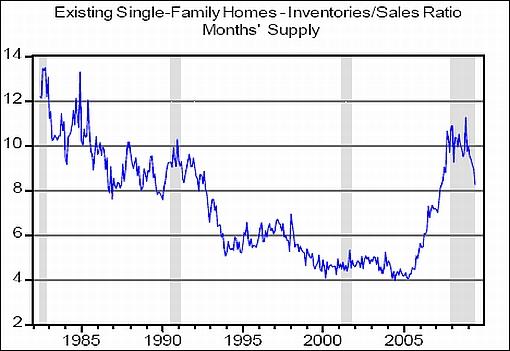
Source: Asha Bangalore, Northern Trust - Daily Global Commentary, July 23, 2009.
Barry Ritholtz (The Big Picture): Seven reasons why housing isn’t bottoming yet
“There are a plethora of reasons why I believe we are nowhere near a bottom in housing prices or activity. Here are a few:
“Prices: By just about every measure, Home prices on a national basis remain elevated. They are now far off their highs, but still remain about ~15% above their historic metrics. I expect prices will continue lower for the next 2-4 quarters, if not longer, and won’t see widespread real increases for many years after that; Indeed, I don’t expect to see nominal increases for anytime soon.
“Mean Reversion: As prices revert back towards historical means, there is the very high probability that they will careen past the median. This is the pattern we see after extended periods of mispricing. Nearly all overpriced asset classes revert not merely to their historic trend line, but typically collapse far below them. I have no reason to believe housing will be any different;
“Employment & Wages: “The rate of unemployment is very likely to continue to rise for the next 4-8 quarters, if not longer. This removes an increasing number of people from the total pool of potential home buyers. There is another issue - wages, and they have been flat for the past decade (negative in real terms), crimping the potential for families to trade up to larger houses - a big source of real estate activity.
“Foreclosures: We likely have not seen the peak in defaults, delinquencies and foreclosures. Many more foreclosures - which are healthy in the long run but wrenching during the process of dislocation - are very likely. These will pressure prices yet lower. And loan mods are not working - they are redefaulting in less than a year between 50-80%, depending upon the mod conditions themselves.
“Inventory: There is a substantial supply of ’shadow inventory’ out there which will postpone a recovery in home prices for a significant period of time. These are the flippers, speculators, builders and financers that are sitting with properties that they do not want to bring back to market yet. Given the extent of the speculative activity during the boom years (2002-06), and the number of foreclosures so far, my back of the envelope estimates are there are anywhere from 1.5 million to as many as 3 million additional homes that could come to market if prices were more advantageous.”
Source: Barry Ritholtz, The Big Picture, July 20, 2009.
Forbes: Commercial real estate - from bad to worse
“Veteran property investor Tom Barrack expects a refinancing crunch over the next few years to cause misery.
“Two years after the credit markets began to freeze up, a crisis looms in the $3 trillion commercial real estate market. Investors who need new funding find themselves without any willing lenders while fundamentals like rising vacancy rates and plunging rents worsen.
“California billionaire Tom Barrack sees opportunity in the wreckage. The chief executive of Los Angeles-based Colony Capital, who made tidy profits by buying up soured up real estate debt during the S&L crisis, talked with Forbes about the troubled commercial real estate market and the broader economy.
“What’s going on in commercial real estate?
“Barrack: It’s bad and it’s getting worse at the moment. The $700 billion commercial mortgage-backed securities (CMBS) market still has no new money for buyers or refinancing. About a third of that is due at the end of 2010 and 2011 and the majority between 2010 and 2012. So you have $750 billion in refinancing needed over the next 24 months and you don’t have one lender.
“Why is it so hard to get new funding?
“Partly because new equity is needed from the owner to provide any loan because the underlying real estate is 30%-50% less valuable than it was at the time of origination. Where is that going to come from? Everybody’s tapped out. All the real estate guys have gone from G4’s to electric golf carts.
“The object of the drill for everyone in commercial real estate - and this is everyone in the world - is just get to the other side of Death Valley. If you can make it to the other side of Death Valley, there’s hope. But even when the economy does start to roll out, commercial real estate takes a while behind the tail of that economy to catch up.”
Source: Maurna Desmond, Forbes, July 14, 2009.
Chart of the Day (Clusterstock): Now this is a misery index!
“Remember the Misery Index? It adds together unemployment and inflation to get a quick and dirty measure of, well, misery. But by this measure, since we’re in deflation, the current recession doesn’t look so bad.
“So Huffington Post came up with its index, which uses the broader measure of unemployment (U6), along with a more narrow basket of prices on essential goods, adding in other things like food stamps and credit card delinquencies. We think HuffPo’s does a much better job of capturing the current misery than the old one.”

Source: Joe Weisenthal and Kamelia Angelova, Clusterstock - The Business Insider, July 22, 2009.
Financial Times: Banks use Tarp funds to boost lending
“A large majority of US banks claim that government bail-out money has allowed them to write new loans to customers, while a minority has used it to buy rivals, according to a report by the programme’s watchdog.
“The audit by Neil Barofsky, special inspector-general for the troubled asset relief programme (Sigtarp), reveals a continuing argument with the US Treasury over how much information should be disclosed by recipients of the money.
“Some 83% of the 360 recipients surveyed by the Sigtarp team said that they had used funds from the government for lending.
“That may provide a boost to both the banks and the Treasury after a week in which Goldman Sachs, one former recipient of Tarp funds, was criticised for preparing to pay large bonuses.
“Some 43% said that they had bolstered their capital cushion, 31% made other investments, 14% repaid debt and 4% made acquisitions.
“While Mr Barofsky’s team celebrated the data as a step towards transparency, the Treasury has declined repeatedly to force banks to report their use of Tarp funds.
“Herb Allison, former chief executive of Fannie Mae now heading the Treasury programme, said in a letter in the report: ‘It is not possible to say that investment of Tarp dollars resulted in particular loans, investments or other activities by the recipient.’
“The Treasury maintains that recipients should not be restricted in their use of Tarp funds, which have been paid as part of this year’s $700 billion programme to shore up the US banking system.”
Source: Tom Braithwaite, Financial Times, July 19, 2009.
By Dr Prieur du Plessis
Dr Prieur du Plessis is an investment professional with 25 years' experience in investment research and portfolio management.
More than 1200 of his articles on investment-related topics have been published in various regular newspaper, journal and Internet columns (including his blog, Investment Postcards from Cape Town : www.investmentpostcards.com ). He has also published a book, Financial Basics: Investment.
Prieur is chairman and principal shareholder of South African-based Plexus Asset Management , which he founded in 1995. The group conducts investment management, investment consulting, private equity and real estate activities in South Africa and other African countries.
Plexus is the South African partner of John Mauldin , Dallas-based author of the popular Thoughts from the Frontline newsletter, and also has an exclusive licensing agreement with California-based Research Affiliates for managing and distributing its enhanced Fundamental Index™ methodology in the Pan-African area.
Prieur is 53 years old and live with his wife, television producer and presenter Isabel Verwey, and two children in Cape Town , South Africa . His leisure activities include long-distance running, traveling, reading and motor-cycling.
Copyright © 2009 by Prieur du Plessis - All rights reserved.
Disclaimer: The above is a matter of opinion and is not intended as investment advice. Information and analysis above are derived from sources and utilizing methods believed reliable, but we cannot accept responsibility for any trading losses you may incur as a result of this analysis. Do your own due diligence.
Prieur du Plessis Archive |
© 2005-2022 http://www.MarketOracle.co.uk - The Market Oracle is a FREE Daily Financial Markets Analysis & Forecasting online publication.



